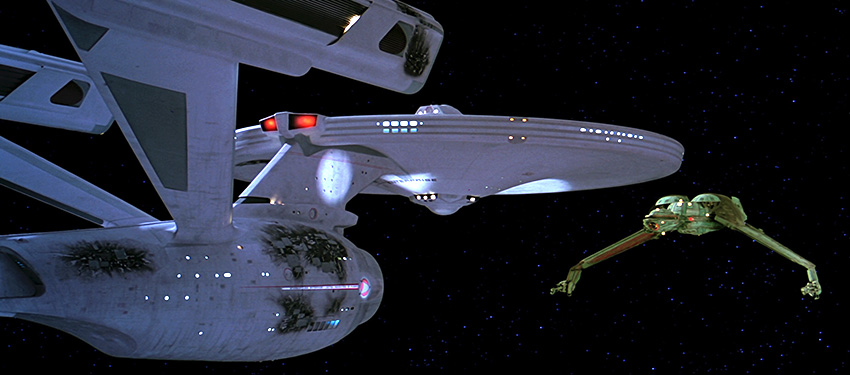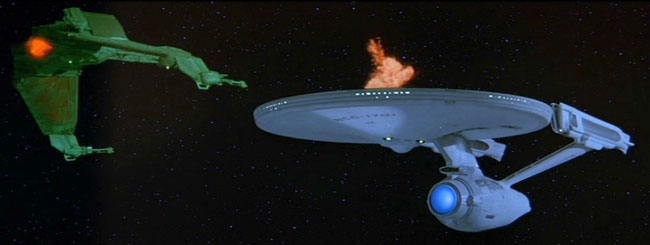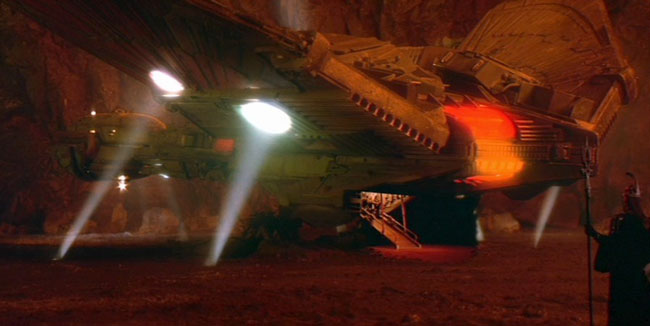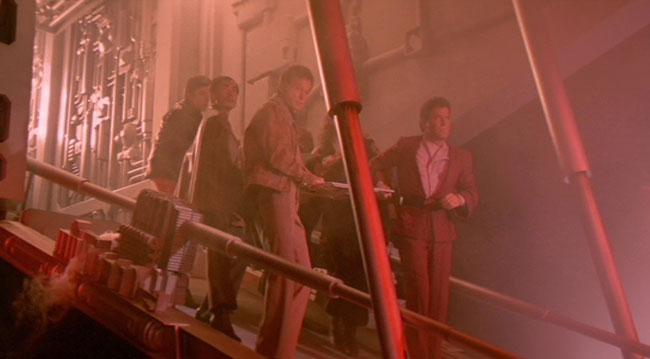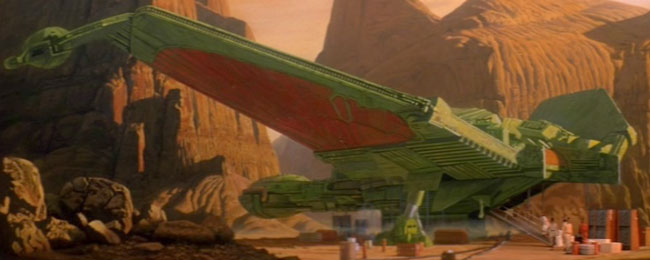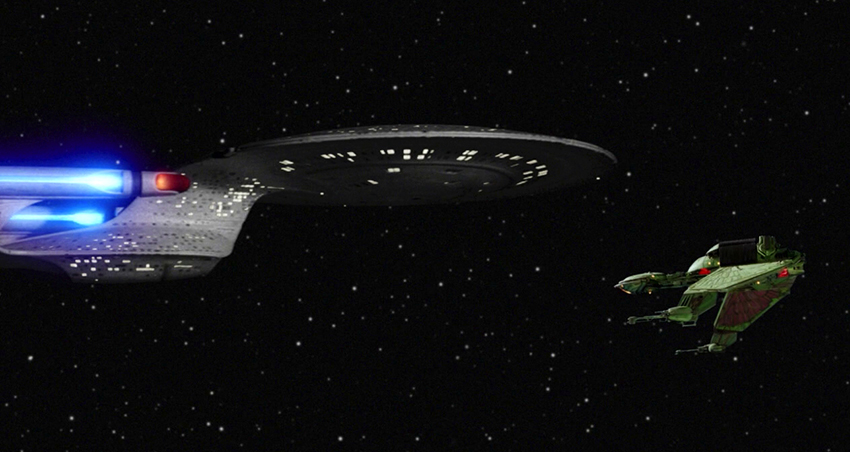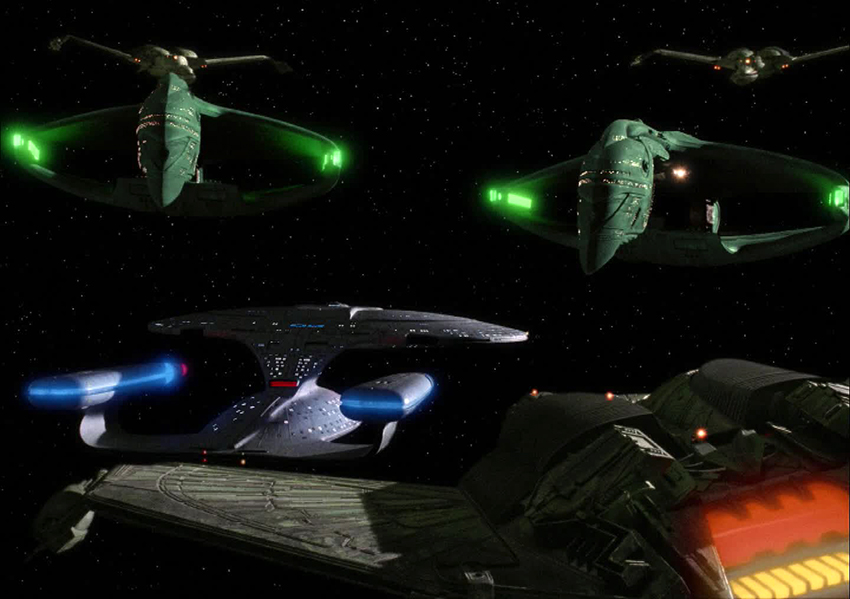Possibly the strangest ship in all of Star Trek history, the Klingon Bird of Prey is one of the most commonly seen Klingon vessels - yet it was originally meant to be a Romulan ship! As the Encyclopedia explains... 'The bird-of-prey was originally established to be Romulan in 'Balance of Terror' (TOS). An early draft of Star Trek III had Commander Kruge stealing a Romulan ship for his quest against Kirk. The Romulan connection was dropped in later drafts, but the ship somehow remained a Bird of Prey.' (3rd edition, 'Klingon bird-of-prey', p244)
Despite this convoluted introduction, the ship would subsequently become virtually the definitive Klingon design. In common with almost every other Klingon ship seen it has the twin hull configuration, with a forward 'head' containing the command centre and a torpedo launcher, an aft engineering hull connected to the head by a thin neck, and a pair of wings attached to the engineering hull. In appearance, the only significant difference between this ship and other Klingon designs is that the Bird of Prey has no nacelles on the wing tips - indeed, it has no nacelles at all! Rather the wings carry a pair of cannon, while the warp coils normally carried within the nacelles appear to be carried within the engineering hull.
The wings themselves have one other unique feature, the ability to be raised and lowered as needed. There are three wing configurations generally used; in normal flight they are generally kept in the horizontal position, during landing operations they are raised to about 30o above horizontal, and during battle they are generally lowered to about 30o below the horizontal. Why this might be has never been specified. Official sources have indicated that hull shape is a factor in the efficiency of warp drive propulsion, in much the same way that it is in aerodynamics. Presumably the level configuration can therefore be thought of as the most efficient shape for travelling in a straight line at high speed, while the wings down position may be better for heavy manoeuvring at warp speed (although most battles take place at impulse, warp speed fighting has occurred on several occasions so the ships must be designed for it). The raised wings for landing would reduce the effective wingspan somewhat, allowing the ship to land in a smaller area, but the difference isn't all that great and seems hardly worth the bother. More likely it's intended to keep the wings and disruptor cannon well clear of the ground during landings, especially during landings on rough ground or in bad weather.
The head section also carries what is widely claimed to be the cloaking device. The raised bump around the centre of the head - sometimes coloured reddish - is often labelled as the 'cloaking coil'. It's not stated whether this is the whole of the cloaking device or just some small part of it, but such devices are generally quite small - the cloaking devices seen in both the TOS episode 'The Enterprise Incident' and in DS9's 'The Emperor's New Cloak' were both about one to two metres long, so this technology hasn't changed size greatly over the last century or so. Given this, the bulge on the Bird of Prey head is more than big enough to house a cloaking device in its entirety.
The housing of warp coils within the main body of the ship is an interesting choice. The tendency to put nacelles away from the ship on most designs indicates that close proximity to the warp coils is in some way undesirable, so presumably those ships which have internal coils suffer a penalty from it. This might be in the form of a less efficient drive system, or perhaps dangerous radiation which would require some type of shielding around the compartment holding the warp coils. If the bird of prey does suffer from some inherent efficiency penalty from having the warp coils within the engineering hull, we could say that the designers went to the trouble of adding variable geometry wings in order to make up for this loss.
As well as the warp and impulse drives, the engineering hull is shown in Star Trek IV to hold the warp core, complete with dilithium chamber, the transporter room, and a small cargo bay. This latter feature will prove to be of major importance in discussing by far the greatest problem with the Bird of Prey design; that of just how large it is. It is this and related issues which the remainder of this article is concerned with.
The Bird of Prey was designed by Nilo Rodis (who also helped to design the Spacedock model seen in this film) and built by Industrial Light and Magic. The designed length of the ship is widely reported to be 109 metres, and the majority of the effects in the first film support this length. The primary hull of the refitted Constitution design is 140 metres across, so looking at the images below we can see that the Bird of Prey is indeed about a hundred metres long.
There is also an earlier shot of the Bird of Prey against a Federation Merchant man. This can only give us the most general idea of sizes, since we have no real idea of how big the latter ship is. But the merchant man is about the size of the Bird of Prey's head and neck together at most. If the Klingon ship is 109 metres, this makes the Merchant about forty metres long, which is reasonable.
Near the end of the film we see scenes of the Bird of Prey, now under the control of Kirk, landing on Vulcan. A ramp extends and the crew leave the ship with Spock's inert body. It's hard to get a good enough quality scan to show the people leaving clearly, but a close up does establish the scale of the ramp well.
Scaling the ship's engines against the ramp then allows a length to be calculated. I got the engines as 5.3 times the height of Kirk. According to the IMDB William Shatner is 5 feet 11 inches, or 180.34 cm, so the engines are 11 metres high. This equates to an overall length of 101.5 metres, which is well within sensible margins of error.
So, the special effects shots of Star Trek III all agree well with the designed length of 109 metres. So far so good.
The problems begin with this film. Consider the scene of Vulcans taking equipment into the ship :
There are two small figures in white on the ramp, carrying a white object between them. These are Vulcans preparing the ship for launch, and they are clearly much larger than Kirk in relation to the engines, and thus to the whole ship. Performing the same calculations as before (I had to assume the Vulcan was the same height as William Shatner), we get an overall length of no more than 55 metres. Put another way, if the Bird of Prey is 109 metres long then the little white figures on the ramp are nearly twelve feet tall. I don't think they grow Vulcans that big...
Now normally I would writer this off as inconsistent special effects, something I'm fairly forgiving of in Trek, but the problems continue. The aforementioned cargo bay features prominently in this film. We are given enough information to determine the bay's size reasonably well. When Kirk is first planning his trip back in time, he asks Scotty how long the bay is and is told 'about sixty feet', i.e. about 18.25 metres. When ordered by Kirk to convert the bay into a water tank for the whales, Scotty goes to plexicorp and asks how thick their plexiglass would need to be 'at sixty feet by ten feet to withstand the pressure of eighteen thousand cubic feet of water'. This confirms sixty feet as the length of the tank and gives a height of 10 feet, or just over three metres. Dividing the volume by the height and length gives us a width of thirty feet, or just over nine metres.
So the tank is 18.25 x 9 x 3 metres. Shots of the tank being installed demonstrate that there is relatively little space above the top of the glass, perhaps a metre or so at most. The scene of the whales being beamed in make it clear that there is a good two metres clearance down the side and at least two or three at the front. Hence we have an overall size for the bay of about 21 x 11 x 4 metres.
The scene of the plexiglass being lowered into place from a helicopter makes it clear that the roof of the bay is just below the upper hull of the ship, while the scene of Kirk swimming out of the escape hatch after releasing the whales near the end of the film makes it clear that the floor of the bay is just above the lower hull. This points to the engineering hull being about five metres tall, which would yield a length for the whole ship of 35 metres! If we add a little more space above the bay and a metre or two below the tank, we can push this height to just about enough that the length fits in with the 55 metres yielded by the scenes on Vulcan.
The scene with Kirk asking how big the bay is then features him and McCoy walking from the bay to the bridge in a sequence that features only two apparently minor cuts. It's a short walk, perhaps twenty five to thirty feet, and apart from a couple of small steps down they remain on the same deck throughout. Putting the bridge this close to the cargo bay does fit in with the 55 metre length. The silhouette below shows a 21 x 4 metre cargo bay within the engineering hull of a 55 metre long vessel, together with the bridge in approximately the right place.
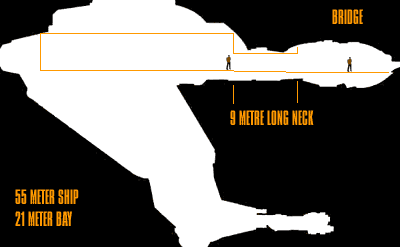
Clearly, this would mean that the cargo bay would take up virtually the entire engineering hull - indeed, when you remember that the wing roots project some distance back behind the engines, then as scaled here the entire warp and impulse drive systems plus fuel and power supply would have to fit into a space of less than two metres behind the bay. At the other end of the ship, putting the bridge slightly down from the bay floor means that there is little space to include a full size torpedo launcher.
If, on the other hand, we scale the image so that the Bird of Prey is the correct length, then the cargo bay becomes much too shallow to allow the top and bottom to touch the hull. Kirk and McCoy's walk to the bridge also has to become much longer than the thirty or so feet seen on the film, and for the bridge to be in the upper part of the head where the escape hatch is it would have to be significantly above the bay, although at least this allows us to have a good sized torpedo launcher in the head. We could explain this latter points by assuming that the two minor cuts in the scene are not really as minor as they seem, giving time for the two characters to travel the additional sixty or seventy feet needed.
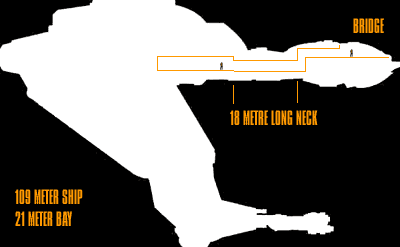
At the end of the film the Bird of Prey crash lands in the water of San Francisco bay, and the crew climb out of an escape hatch located in the bridge and stand on the bulge of the cloaking device. William Shatner stands approximately such that his height is half the distance between the cloaking bulge and the top of the hull - it's hard to say for sure as he never stands in an ideal position for scaling, but I've judged the height as best I could. This means that the distance from bulge to top of hull is about 3.6 metres. Scaling that to the rest of the ship gives us a length of 90 - 110 metres, which is just about right for the 109 metre designed length!
The best we can say about the size of the ship in this film is that it's inconsistent. We know that the same vessel is being used in both films, so unless we are to claim that the Vulcans used some kind of 'shrink ray' on it, they must be the same length. The 109 metre length leaves us with the fundamental problem of the bay not being tall enough to touch the hull at top and bottom, but the bulk of the evidence does suggest this length so I think we have to assume that it is correct.
Another Bird of Prey appears in Star Trek V. There are relatively few scenes which allow us to judge the size of it, but there is one good comparison with the Enterprise at the end of the film. The Bird of Prey appears to be fifty eight metres across, which would make it about forty metres long. This is the shortest of the lengths we've looked at so far, even shorter than the 55 metres some scenes indicate for the ship in Star Trek IV.
In Star Trek VI we meet another Bird of Prey, a modified version designed to fire torpedoes whilst cloaked. There is no scene which allows its size to be compared with a known object. My assumption is that this vessel is based on the hull of a standard 109 metre long Bird of Prey.
In Generations we meet another variant, this one described as 'a class D12 Bird of Prey'. These were described as having been retired due to defective plasma coils, a part of the cloaking device. Picard refers to this specific ship as being twenty years old, so they must have been in production until at least 2351. Despite the disparaging way Picard talks says this line, twenty years is not all that long in Starship terms - the Enterprise-D was already seven years old at this point, after all. However, if the date at which the class was retired was also 2351 or thereabouts, making this particular ship one of the last built, then they would have gone twenty years without significant upgrading of their systems. This would better account for the condescending attitude towards the ship, since it's established in 'Yesterday's Enterprise' that twenty two years is sufficient time for a whole new generation of weapons technology to evolve.
There are none of this vessel in First Contact or Insurrection.
The Bird of Prey design makes several appearances in the next generation, and it is here that the sizing problems begin in earnest. The first appearance is in 'A Matter of Honor'. In this episode we get a good comparison of the Enterprise-D to the Klingon ship Pagh :
The distance between the front of the E-D primary hull and the front of the bussard collector is 385 metres. The Pagh works out to 165 metres on a straight comparison, but since the ship is turned away from us by about 45
o, this will foreshorten it to about 70% of it's true length, so the ship is actually 235 metres long. Another comparison with the Enterprise near the end of the film points to a length of well above 290 metres! The internal details of the ship are also somewhat different from the 109 metre variant Kirk used. Most significantly, the bridge seems to be significantly larger than the one on Kirk's ship. This doesn't necessarily prove that the whole ship is larger, however - as the 109 metre silhouette of Kirk's ship shows, there is plenty of room in the head which the bridge could have been expanded into.
In 'Yesterday's Enterprise', we see ships identical in shape to the Bird of Prey which Riker described as 'K'Vort class battlecruisers'. These ships are shown in several comparison scenes with the Enterprise-D, all of which clearly depict them as being much, much larger than a normal Bird of Prey. It's hard to judge precisely, but the ships seem to be 300 - 400 metres long in most scenes.
In 'Redemption, Part I', two Bird of Prey type ships attack the Vor'cha class Bortas. The ships are about 300 - 350 metres long when compared to the 457 metre long Vor'cha. In Part II we see several Bird of Prey type ships fighting, but since all are identical there is nothing with which to compare them so no size can be determined.
In 'The Defector', we see the most amazing sized design of all. Have a look at this :
The ships are clearly behind the D'deridex class ships - the one on the left is even partly hidden behind the hull of the warbird. The D'deridex is at least 770 metres across according to the DS9 TM, and most other sources point at a size equal to or greater than this. Even if the Klingon ship was at an equal distance it would be well over five hundred metres wide. Since it must be at least a few hundred metres behind, the width rises to well over six hundred metres.
Finally, we have the season episode 'Rascals'. In this the Enterprise comes under attack by Bird of Prey type ships which are described as 'B'rel class'. Strangely enough, the special effects used to depict these ships are a re-use of the 'Yesterday's Enterprise' footage, so the same length of 300 - 400 metres applies.
Some interesting comparisons are possible in 'Way of the Warrior'. Several Bird of Prey style ships can be seen, firstly in the attack on the Cardassian Galor class vessel which the Defiant goes to meet. It's hard to judge the size of these ships, but the scene in which one of them chases the Defiant in close proximity to a Vor'cha class assault cruiser makes it look about right for the 109 metre length.
However, the most interesting shot is this one :
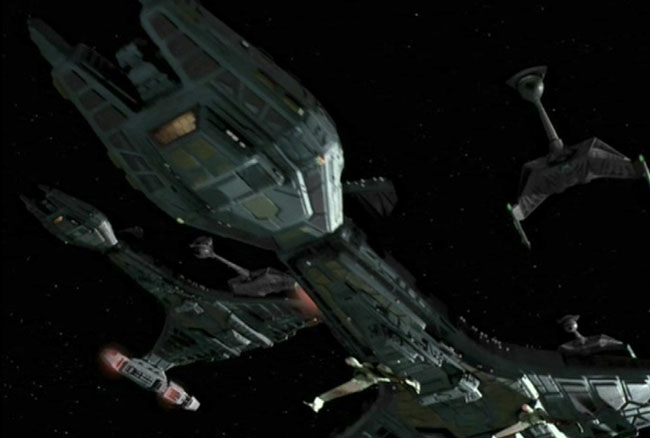
The Bird of Prey style ships are directly beneath the Vor'cha, and in comparison are absolutely tiny! I scaled one against the Vor'cha's front module, and got a length of 28 metres for it! This is so small that we would have difficulty in accommodating people inside it - you wouldn't be able to walk down the neck without stooping over. We can cure this problem by stretching the design just a little while still not going too far from the shot above - 35 metres seems to be an absolute minimum. Here's what a 35 metre ship looks like, with some Klingon warriors added to give an idea of scale :
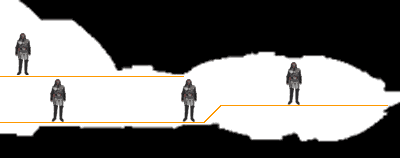
As you can see, there is just enough room in a 35 metre ship for a person to stand upright in the neck section while the engineering hull is just deep enough for two decks if needed. The head is just deep enough to accommodate a single deck with a space beneath for a weapon, although since we never see one of these ships fire during the episode there's no way to be certain that they carry a weapon here. Still, there is enough space for a disruptor or small torpedo launcher.
The next issue Deep Space Nine brings up is the Rotarran, General Martok's Bird of Prey. This is depicted as being about 137 metres long. Officially it's a variant of the 109 metre version. However, the 137 metre figure is depicted against the Defiant or Deep Space Nine itself, both of which have sizing issues of their own. Size figures for the Defiant vary from around 60 to 170 or more metres, and 170 metres has come to be the official figure. However, most of the evidence points to a figure of around 120 metres. If we use this in the comparisons with the Rotarran, then Martok's ship drops from 137 to 97 metres... not too far off the 109 metre 'true' figure. Certainly if the Rotarran is sized against the Defiant there is enough uncertainty in the figure to allow a 109 metre figure to be correct. As for DS9, the official diameter in the DS9 TM is 1,451.82, but this makes the promenade windows on the model of the station something like 20 feet tall! The station was originally designed to be rather smaller than this, but the size was changed during development of the show for some reason (perhaps so a Galaxy class starship could fit to the station in the pilot episode). So sizing the Rotarran against DS9 also has its problems.
The official version of events is given in the Deep Space Nine Technical Manual, which states that there are two types of Bird of Prey. These it calls the B'rel and the K'vort. It claims the B'rel is 157.76 metres long, 181.54 metres wide and 98.54 metres tall while the corresponding figures for the K'vort are 678.36, 780.62 and 423.72 metres respectively. Rick Sternbach has indicated on his news group that the K'vort figures were dictated by the scene in 'The Defector' showing the Klingon ship close to the Romulan warbird. Unfortunately, this story doesn't hold very close to the facts. The only mention ever of a K'vort class was in the alternate timeline of 'Yesterday's Enterprise'. There is absolutely no use of this word outside that episode. The only use ever made of the B'rel name is in 'Rascals', in which it is applied to a ship which is identical to the K'vort. It has to be identical to the K'vort, because the same piece of film is used for both ships! So, the B'rel must be around 300 metres long. The K'vort could exist within the regular Trek timeline as a variant on the B'rel, but since there's no actual evidence of it then really, it's simpler to assume that any 300 metre versions of the design are actually B'rels.
As far as the DS9 TM sizes are concerned, they are right that 'The Defector' indicates a variant of the Bird of Prey which is over six hundred metres long. But the length of 157.76 metres for the smaller variant in the book is too long for the 35 and 109 metre version Bird of Prey, and too short for the 280 and 300 metre version. So while the DS9 TM has the size of the 600 metre version about right, but not the name, it has both the name and size of the smaller ship wrong and ignores the evidence of a 35 metre and 300 metre version completely. This is not to denigrate Rick Sternbach's work on the book or claim he is incompetent in any way. Rather, I think he just tried to come up with a reasonable compromise of one big and one small ship. He used the only two proper class names mentioned in the show and seems to have picked a size for the smaller one which is roughly in the middle of the 35 metre - 280 metre range, while his size for the bigger one conforms to the biggest version shown. It's a reasonable compromise attempt, but it's not necessarily the best explanation of the screen evidence.
There are those who choose to believe that all depictions of ships at other than their designed size are nonsense, and just chalk it up to errors in the special effects. This is a perfectly reasonable thing to do, but personally I've always favoured explanations that explain as many aspects of canon as possible. There's no inherent reason why a ship design cannot be scaled up whilst keeping its external appearance identical, as I explain on the scaling article. It's purely a matter of personal choice, and while official sources clearly think that two variants of the ship are enough, I don't mind having more. I've complained in the past that species like the Klingons and Romulans don't have anything like enough ship designs in their fleet when compared to the legions of Federation classes, so I'm more than happy to flesh things out a bit.
So far as I can tell, there are four different distinct sizes for the Bird of Prey design. Firstly, the 109 metre version. The first in service, this is the one Kirk used in Star Trek III/IV. I choose to ignore the evidence that this ship is 55 metres or so long since the majority of the evidence says otherwise. This ship seems to exist in at least four distinct versions; the one Kirk used, Chang's modification, the D-12, and the version which is still in use in the TNG/DS9 era of which the Rotarran is a member. We could assume that Kirk's original model was in fact a D12, but it seems odd that a ship could be in continuous production for at least sixty six years before then being retired en masse because of a faulty cloaking device. I call Kirk's ship a D11, Chang's a D11A, and the TNG era version the D13. Realistically there should probably be several more versions between the D11 and 12, but I've stuck with the minimum for the sake of simplicity.
In TNG, the same design is often 280 - 400 metres long. You could probably spin off half a dozen or so variants within this range - virtually every depiction of a ship is going to scale it slightly differently, due to the nature of the special effects process. For the sake of simplicity I choose to call all of these a single variant which is 327 metres long. I pick the upper end of the range because it is the only depiction which has received a name in canon - the B'rel.
The ship seen in 'The Defector' seems to be another variant, this one over 600 metres long.
Finally, there is a variant which is rather smaller than the normal Bird of Prey - the 35 metre long version seen in 'The Way of The Warrior'.
We have no names for any of these ships besides the B'rel and the D12 variant of the 109 metre ship, which is why I have been forced to invent names for the very large and very small variants. For the 109 metre model I have just stuck with a generic 'Bird of Prey' tag, with the invented D numbers to distinguish them. For the others I have invented Klingon sounding names. So here are the variants :
| Length | Scaling
Factor | Name | Description |
| 35 metres | 0.321 | K'pak | Seen in 'Way of the Warrior'. Name is speculation. |
| 109 metres | 1 | Bird of Prey
(D11/12/13) | Actual designed size of the original model, supported by most of the evidence from ST III/IV. Variants of similar size appear in further films and TNG/DS9. D numbers of all but the D12 are speculation. |
| 327 metres | 3 | B'rel | Seen and named as the B'rel in 'Rascals'. Ships of this approximate size in TNG are assumed to be B'rel class also. |
| 654 metres | 6 | T'pai | Seen in 'The Defector'. Name is speculation. |
So that's the story behind the Bird of Prey, surely one of the most convoluted designs in all of Star Trek history!
Colour key


